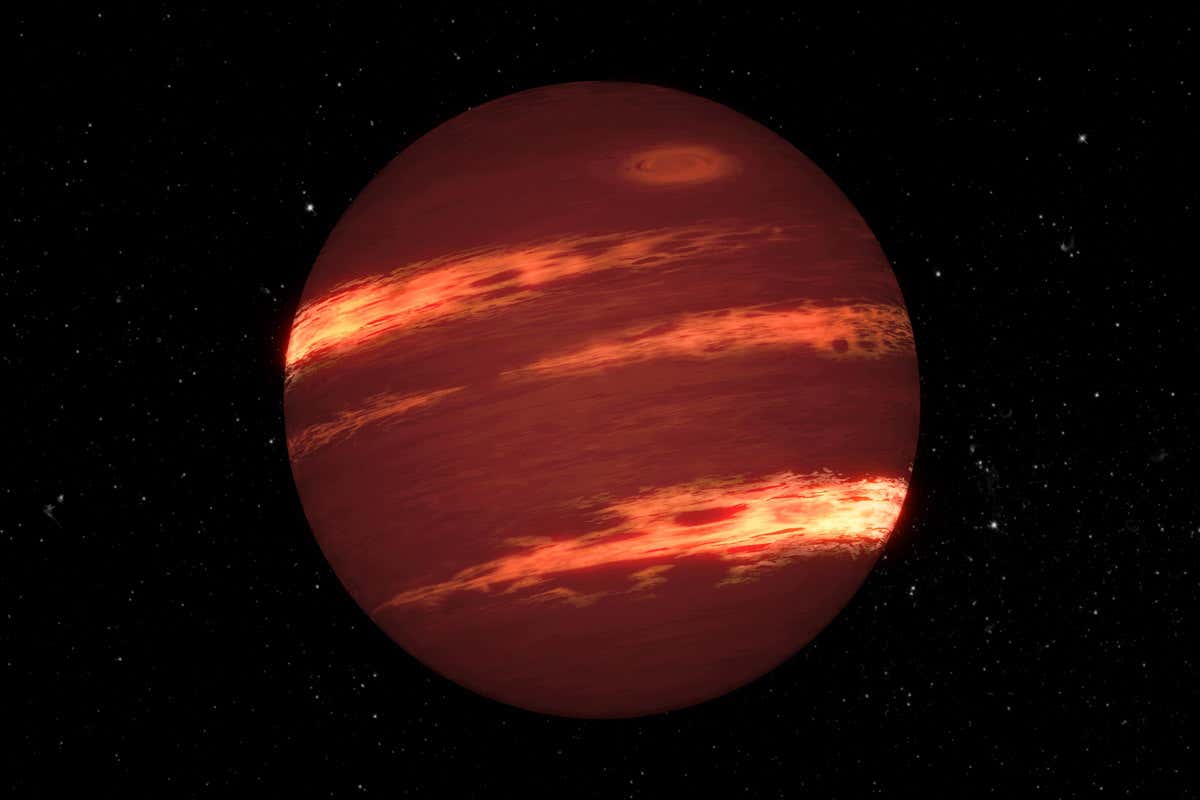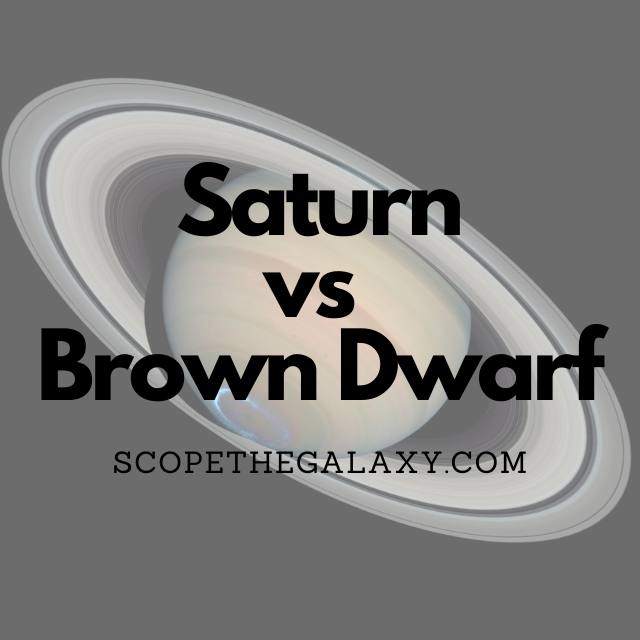*This post may contain affiliate links. This means we may make a commission if you purchase an item using one of our links*
The main differences between Saturn and a brown dwarf is that the former is a yellow gas giant planet orbiting the Sun in our solar system whereas the latter is a brown colored failed star that was unable to become a main sequence as it was unable to gather sufficent mass when initially forming.
There are a variety of differences between these two entities and a few similarties which has resulted in many possibly believing that the pale yellow gas giant was initially a failed star. For a more indepth look into these subject matters among other thing, continue reading as it will be discussed below.
What Is The Planet Saturn?
Table of Contents

Saturn is the second largest planet in our solar system, that has a multitude of rings surrounding its gaseous exterior. It’s also the 6th farthest planet from the Sun.
As Saturn falls under the gas giant moniker, the planet is mostly made up of gases. However, Saturn’s composition is a little different from Jupiter’s where its atmosphere is mixture of hydrogen and ices containing elements of Ammonia.
It’s core on the other hand is comprised of a dense core of nickel and iron, which is then surrounded by rocks compressed so strongly that it can tends to reach scorching hot temperatures of 11,700+ degrees celsius.
On the other hand, It’s gaseous atmosphere is far cooler. The exterior generally sits in the extreme sub zero range where Saturn’s temperatures is -138 degrees celsius.
This is generally constant throughout the yellow ringed giants day to day. In fact it’s much colder than even the coldest place on Earth, which would be Eastern Antarctic Plateau, Antarctica that hits -94 degrees Celsius, which is more than 40 degrees celsius warmer.
Being so large, Saturn’s gravitational pull is obviously strong. That’s why over it’s 4.5 billion years of existence, beyond its rings this yellow gas giant has managed to accumulate 82 different moons along with other smaller interstellar debris that now orbit it.
In fact it’s largest moon Titan is literally bigger than one of the 8 planets orbiting the Sun, Mercury.
Saturn also orbits the Sun but, as the 6th farthest planet from it, it does mean a singular orbit will take it 29.4 Earth years to complete. In comparison to its axial orbit which only takes 10.7 hours, this is an extremely long time.
What Is A Brown Dwarf?

The fate of a star is determined mainly by its mass. Every star is born with significant mass that produces immense gravity and heat in its core.
These temperatures are so intense that nuclear fusion begin to act upon the elements surrounding it, providing both a source of energy and luminous look of any given star.
A brown dwarf is a star that is only a fraction the size of our sun.
Astronomers often use Jupiter as a standard measure, where for example if a stellar body were to have a mass of more than 13 Jupiters, this would mean that the celestial entity in question would then have sufficient energy within its core to spark a nuclear reaction and fall under the classification of a brown dwarf.
However, this reaction involves burning deuterium – or heavy hydrogen – rather than the regular hydrogen that fully-fledged stars use.
In order to burn ordinary hydrogen, a star needs a minimum mass of 75 Jupiters. Anything that sits within these upper and lower limits can be considered a brown dwarf.
In essence, a brown dwarf is a stellar object that sits between the mass of a large planet and a small star with insufficient mass to sustain nuclear fusion. A brown dwarf can also be called a “failed star.”
From a distance, brown dwarfs may share a similar appearance to a red dwarf, but red dwarfs fuse and convert ordinary hydrogen which is what differentiates them from a brown dwarf.
Was Saturn Ever A Brown Dwarf?
As both Jupiter and in this case Saturn fall under a size range that could fit within that of failed brown dwarf stars and are similar in compostion, some have asked this question
However, the short answer to this question is no, Saturn never was a brown dwarf
This is mainly down to the fact that this yellow ringed gas giant simply does not have enough mass.
For a brown dwarf to form, sufficient mass would be required. A brown dwarf needs at least 13 Jupiter’s worth of mass and well, Saturn is the least dense gas giant in our solar system whilst Jupiter is the second most dense gas giant therefore, it’s not even close to meeting this barrier.
As for size, brown dwarfs will typically fall between 0.8 to 1.2 time the size of Jupiter. Saturn is around 0.83 times the size of Jupiter thus, Staurn does fall under this bracket.
Ultimately, sufficient mass is required to form a star, even if it’s a failed brown dwarf star. From this nuclear fusion is possible, which is a primary function of any given star.
Saturn does not have enough mass therefore, despite its similarities in size with brown dwarfs, it simply does not tick all the boxes needed to become one or to have ever been one.
How Are Saturn And Brown Dwarfs Similar?
Other than the facts that Saturn has a similar hydrogen and helium compostion like all stars, it has a core at its center, is similar in size to a brown dwarf and is spherical in shape, the two fall under different brackets for celestial beings much like moons are different from comets and so on.
Beyond these realtively small commonalities, Saturn and brown dwarf are quite different from one another as you’ll see below.
Differences Between Saturn And Brown Dwarfs
As for the differences between Saturn and brown dwarfs, they would include the following:
- Saturn is pale yellow in color whilst brown dwarfs are generally a dark brown color
- Brown dwarfs still convert heavy hydrogen into helium whilst Saturn cannot do this.
- Brown dwarfs have a stronger magnetic field than Saturn.
- Saturn is significantly lighter than a brown dwarf where the typical brown dwarf will fall between 13 – 80 Jupiter’s in mass whereas Saturn is roughly half the mass of Jupiter.
- Brown dwarfs can produce light but, Saturn is unable to do this as it is a planet.
- Saturn is far colder than a brown dwarf with temperatures around -140 degrees celsius whilst a brown dwarf typically resides around the 125 – 175 degreees celsius range.
- Gas giants like Saturn are likely way more abundant than stars let alone failed stars.
Summary
Saturn and Jupiter are completly different entities from one another, whether it be their mass, their lifespan, temeprature, color and overall existence.
Yes, they may be realtively similar when it comes to composition and size however, the differences between the two are simply too grand to compare, afterall one is just a gas giant whilst the other is a star that is theortically able to create its own light and energy due to nuclear fusion.

